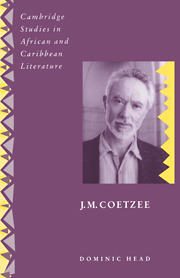Book contents
- Frontmatter
- Contents
- Preface
- List of abbreviations
- Chronology
- 1 The writer's place: Coetzee and postcolonial literature
- 2 Writing violence: Dusklands
- 3 The wrong kind of love: In the Heart of the Country
- 4 An ethical awakening: Waiting for the Barbarians
- 5 Gardening as resistance: Life and Times of Michael K
- 6 The maze of doubting: Foe
- 7 A true confession: Age of Iron
- 8 Producing the demon: The Master of Petersburg
- Notes
- Select bibliography
- Index
7 - A true confession: Age of Iron
Published online by Cambridge University Press: 01 March 2010
- Frontmatter
- Contents
- Preface
- List of abbreviations
- Chronology
- 1 The writer's place: Coetzee and postcolonial literature
- 2 Writing violence: Dusklands
- 3 The wrong kind of love: In the Heart of the Country
- 4 An ethical awakening: Waiting for the Barbarians
- 5 Gardening as resistance: Life and Times of Michael K
- 6 The maze of doubting: Foe
- 7 A true confession: Age of Iron
- 8 Producing the demon: The Master of Petersburg
- Notes
- Select bibliography
- Index
Summary
The projected silencing of the post-colonizer at the end of Foe, signalled by an anticipated post-colonial history, continues a leitmotif of relinquishment that runs through the novel sequence, and which becomes the dominant feature in Age of Iron (1990). This novel takes the form of a letter narrated by the elderly Mrs Curren, and notionally addressed to her daughter in the United States. Mrs Curren, a retired classics lecturer, begins writing on the day she is diagnosed as suffering from terminal bone cancer. The dynamic of the novel is that of personal dissolution involving Mrs Curren's relinquishment of all personal investment in life in South Africa, a movement which is necessary to generate a reverse process, the gradual acquisition of political enlightenment. The novel is thus a paradoxical, inverse novel of personal development, a procedure which depends upon the self's acceptance of its own unimportance.
On the day that Mrs Curren is given her bleak diagnosis, she is ‘adopted’ by an alcoholic down-and-out named Vercueil, an impassive shadowy character (his race is not mentioned) who accompanies her – without offering her comfort or succour – on her path to death and semi-enlightenment. He eventually agrees to take responsibility for posting the letter which forms the novel to the US after Mrs Curren's death, though his unreliability makes him an improbable messenger. The idea that Vercueil may represent an angel of death to Mrs Curren introduces an allegorical dimension to the novel, but one which is clearly held at the level of ideas, even within the world of the text.
- Type
- Chapter
- Information
- J. M. Coetzee , pp. 129 - 143Publisher: Cambridge University PressPrint publication year: 1998



